Glass House
The Glass House, or Johnson house, is a historic house museum on Ponus Ridge Road in New Canaan, Connecticut built in 1948–49. It was designed by Philip Johnson as his own residence, and "universally viewed as having been derived from" the Farnsworth House in Plano, Illinois design, according to Alice T. Friedman. Johnson curated an exhibit of Mies van der Rohe work at the Museum of Modern Art in 1947, featuring a model of the glass Farnsworth House.[3] It was an important and influential project for Johnson and for modern architecture. The building is an example of minimal structure, geometry, proportion, and the effects of transparency and reflection. The estate includes other buildings designed by Johnson that span his career. It was designated a National Historic Landmark in 1997. It is now owned by the National Trust for Historic Preservation and is open to the public for guided tours, which begin at a visitors center at 199 Elm Street in New Canaan.
Philip Johnson Glass House | |
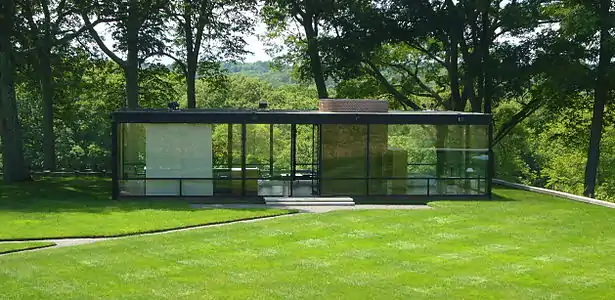 Glass House | |
  | |
| Location | 798–856 Ponus Ridge Road, New Canaan, Connecticut |
|---|---|
| Coordinates | 41°8′32.73″N 73°31′45.84″W |
| Built | 1947-1949 |
| Architect | Philip Cortelyou Johnson |
| Architectural style | Modern Movement |
| NRHP reference No. | 97000341 |
| Significant dates | |
| Added to NRHP | February 18, 1997[1] |
| Designated NHLD | February 18, 1997[2] |
The house is an example of early use of industrial materials in home design, such as glass and steel. Johnson lived at the weekend retreat for 58 years with his longtime companion David Whitney, an art critic and curator who helped design the landscaping and largely collected the art displayed there.[4][5][6][7]
House and property
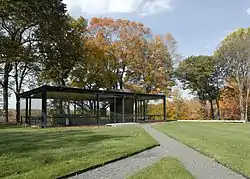
The house is mostly hidden from the street. It is behind a stone wall at the edge of a crest in Johnson's estate overlooking a pond. Visitors walk over grass and gravel strips as they approach the building.[5] The building is 56 feet (17 m) long, 32 feet (9.8 m) wide and 10½ feet (3.2 m) high. The kitchen, dining and sleeping areas were all in one glass-enclosed room, which Johnson initially lived in, together with the brick guest house (later the glass-walled building was only used for entertaining).[8] The exterior sides of the Glass House are charcoal-painted steel and glass. The brick floor is 10 inches above the ground. The interior is open with the space divided by low walnut cabinets; a brick cylinder contains the bathroom and is the only object to reach floor to ceiling.

The house builds on ideas of German architects from the 1920s ("Glasarchitektur"). In a house of glass, the views of the landscape are its "wallpaper" ("I have very expensive wallpaper," Johnson once said.[5]) Johnson was also inspired by the design of Mies van der Rohe's Farnsworth House. Glass House contains several pieces of furniture designed by Mies.[5]
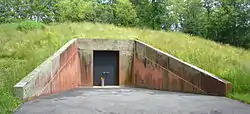
The landscape surrounding the buildings was designed by Johnson and Whitney, with manicured areas of gravel or grass, trees grouped in what Johnson called outdoor "vestibules", and with care taken in the shape of the slopes and curves of the ground. In part, the landscape was a reflection of a landscape painting, The Funeral of Phocion by Nicolas Poussin (circa 1648) placed in a seating area of Glass House. The view through the glass walls to the landscaped grounds was strikingly similar, as Johnson designed it to resemble Poussin's picture. The estate overlooks the valley of the small Rippowam River to the west (seen from the back of Glass House, past a grassy rise). To the north and south are sloping scenery that particularly mimic the painting.[5]
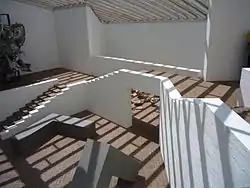
Johnson's rambling estate, originally 47-acre (190,000 m2), also includes 13 Modernist structures Johnson built, including the "Brick House" (1949–1950), which serves as a guest house, the pavilion (1962), Painting Gallery (1965), sculpture gallery (1970), the study (1980), the ghost house (1982), the Kirstein Tower (1985) (named for Johnson's friend Lincoln Kirstein) and the gate house ("Da Monsta", 1995).[9][5]
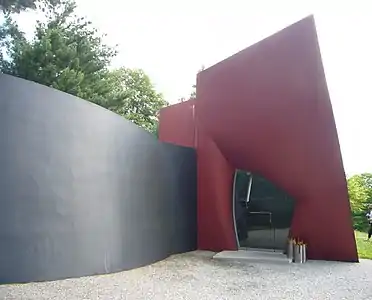
The collection of structures vary between rectangular and circular. The rectangularity of the Glass House itself is complemented with a circular brick fireplace. The Brick House, also rectangular, faces the Glass House, but a nearby concrete, circular sculpture by Donald Judd (untitled, 1971) and small circular pools on either side of it serve to soften the rectangular effect, although structures and objects throughout the estate are arranged to show patterns or repetitions of curves and angles.[5]
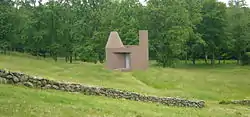
Several buildings on the property served specific functions: The Glass House was used eventually only for entertaining, and Johnson slept in the Brick House (which was initially used for guest rooms, Johnson's study and a picture gallery), the study was used for work and the galleries for storing and displaying the art collection.[8] Johnson called other buildings his "follies" because their size, their shape or both made them unusable, such as the low-ceilinged Lake Pavilion or the Ghost House, a structure built with chain-link fencing on the foundation of an old barn and with lilies planted inside.[10] Three other existing vernacular houses on the estate (Popestead, Grainger, and Calluna Farms) were remodeled by Johnson.[11][5]
The red and black "Da Monsta" gatehouse, built without right angles and from modified gunite, is one of the few structures visible from the road.[12] Near it is a 20-foot (6.1 m)-high entrance gate, fashioned out of a sailboat boom.[5] In the 1997 documentary, Philip Johnson: Diary of an Eccentric Architect,[13] Johnson discusses the buildings he built on the property (his "diary") with a focus on "Da Monsta", at that time the latest structure. "Da Monsta" was inspired by the work of German expressionist architect Hermann Finsterlin.[12] The name was chosen after a conversation with architecture critic Herbert Muschamp as Johnson felt the house had the quality of a living thing.[12]
The Painting Gallery building is built underground with an entrance modeled on Agamemnon's Tomb. Paintings are displayed on a system of three revolving racks of carpeted panels.[9] Johnson and Whitney acquired a large collection over 40 years, but much was sold to support the trust after Johnson's death. The gallery still includes a portrait of Johnson by Andy Warhol as well as works by Frank Stella, Jasper Johns, Julian Schnabel and Robert Rauschenberg.[5] Whitney, a friend of Warhol, Johns and Rauschenberg, took the lead in shaping the art collection.[6]
History
In Johnson's lifetime (1906–2005)
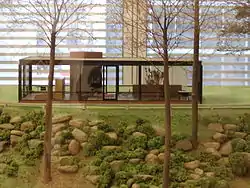
Johnson spent three years designing the structure, which was originally one of two buildings (along with the brick guest house) on what was then an 11-acre (45,000 m2) tract.[14]
The Glass House resulted in recognition for Johnson, not just in architectural circles, but also among the public at large. The house was featured in Life magazine, and the New York Times Magazine published a set of cartoons about it.[8] "What really sets Johnson apart [...]" Michael Sorkin wrote in 1978, "is his aptitude for publicity." The Glass House "established Johnson as the titular leader" of Modernist style in 1949. "If it was Mies van der Rohe who provided the real inspiration for the Glass House [...] it was only Johnson who could have built the house and lived in it himself. Johnson's career began when he turned himself into the Man in the Glass House. In an instant, he became the austere apostle for modern architecture—or rather the modern apostle for austere architecture."[15] As Life magazine put it in 1949: "Except when entertaining, Johnson lives alone, servantless and accompanied only by weather, paintings and books."
The building created such a stir that at one point a police officer was posted nearby to keep out trespassers, and Johnson put up a sign near the street, stating: "This House Is Now Occupied Please Respect the Privacy of the Owner. It will be Open to the Public on specified days".[8] New York Times architecture critic Nicolai Ouroussoff wrote in 2007 that Glass House was "once one of the most famous houses in the United States. [...] [I]ts celebrity may have done more to make Modernism palatable to the country's social elites than any other structure of the 20th century."[16]
The home also created a stir for Mies van der Rohe, who "stormed out in a huff when he saw it", Ouroussoff wrote. Obviously derived from Mies's Farnsworth House, the fact that it was finished earlier could easily have made the German architect wonder whether others would get the impression that Johnson had instead done pioneering work for Mies, and it could be seen that "Johnson's vision lacked the intellectual rigor and exquisite detailing that were so critical to Mies's genius", according to Ouroussoff.[16]
As a curator at the Museum of Modern Art, Johnson had publicized Mies' work, and the American acknowledged his debt to the German architect, particularly in a 1950 interview in Architectural Digest magazine. Even though Johnson's building was completed a year before Mies's glass house, Johnson's building "was universally viewed as having been derived from it", according to Alice T. Friedman. Johnson curated an exhibit of Mies work at the Museum of Modern Art in 1947, featuring a model of the glass Farnsworth House.[3]
For many Yale University architecture students, it was considered a rite of passage for decades after the house was built to sneak onto the property and see how long they could walk around until Whitney discovered them and told them to leave.[5]
After Johnson
Johnson wanted to preserve his estate as a public monument "with the aim of cementing his legacy", even building Da Monsta as a visitors pavilion, according to architecture critic Nicolai Ourousoff (although after Johnson's death, National Trust officials decided instead to build a Visitor Center in downtown New Canaan).[16]
The house was declared a National Historic Landmark in 1997.[2][17] The house was the place of Philip Johnson's passing on January 25, 2005 at the age of 98. Whitney, his partner, died later the same year and left a bequest to support programming and maintenance of the site.[6] Johnson passed on ownership of the Glass House to the National Trust for Historic Preservation, which opened it to visitors in April 2007. The trust expanded the size of the property, buying adjacent lots which extended it to 200 acres (0.81 km2).[5]
When the Glass House estate first opened for public tours in 2007, tickets sold out quickly. By July 2010, 15,000 visitors had taken the tour.[5]
Reception
"It is still considered one of his best buildings," according to the Encyclopedia of American Architecture (1980).[14]
Glass House itself is inferior to Farnsworth House in "intellectual rigor" and exquisite detailing, according to Nicolai Ouroussoff. For instance, he wrote, the steel I-beams at the corners of Johnson's building "are clumsily detailed—especially disconcerting in a work of such purity." Nevertheless, the building is "a legitimate aesthetic triumph", with the glass walls beautifully layering silhouetted and reflected images layered on each other, the critic wrote. "[T]he classical references alluded to by its thin brick base and the symmetrical proportions of its frame demonstrate the range of Johnson's historical knowledge."[16]
He criticized the underground picture gallery as too "dark and somber", and said the ability to flip the paintings on movable walls is a more rigid situation than it might first appear, since only six works can be seen at any one time. Ouroussoff praised the sculpture gallery as pleasingly open and rejected criticism that the shadows cast by rafters beneath the skylights distorted the look of the sculpture—he thought the changing shadows enhanced the artwork.[16]
The poor energy efficiency of the Glass House has been widely discussed.[18]
Tours and the Visitor Center
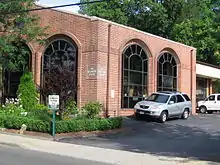
Tour groups are limited to 13 people and include a 3/4-mile walk through the estate.[6] Tours begin and end at the Visitor Center in downtown New Canaan, Connecticut (across from the train station), where vehicles transport each group to the site near the New Canaan–Stamford border. "Standard" tours last 90 minutes and flash photography is not allowed. There is a pure glass tour that only visits the house and is an hour long. Extended tours last two hours and cost more. Tours at twilight and "personalized" tours are also offered.[19] Special Events include a "Dine with Design" picnic and film festival, as well as regularly scheduled Conversations in Context which feature prominent figures in the architecture and design community and take place for a limited number inside The Glass House.
The Visitor Center, which was designed to reflect Johnson's uncluttered aesthetic, includes a "media wall" with multiple video loops running simultaneously on a wall with 24 computer screens. The screens, not meant to be viewed in any order, are meant to reflect the many facets of the architecture, art, landscaping and other features of the estate. When the Visitor Center opened, each of the screens was running a video loop of between two and 20 minutes, centered on a different theme, with a quotation from Johnson, Whitney, or their friends or colleagues.[6]
Along with regular tours, special tours are offered for architects and for artists and museum curators. The latter tours may spend extra time in the Painting Gallery and Sculpture Gallery.[5]
See also
- Booth House, Johnson's first residential commission & a stylistic precursor to the Glass House
- Farnsworth House
- Harvard Five
- Landis Gores House
- List of National Historic Landmarks in Connecticut
- Manitoga
- National Register of Historic Places listings in Fairfield County, Connecticut
- Noyes House
- Richard and Geraldine Hodgson House, across the street from Glass House
- Urban Glass House, Johnson's final commission, inspired by the Glass House
References
- "National Register Information System". National Register of Historic Places. National Park Service. January 23, 2007.
- "Philip Johnson Glass House". National Historic Landmark summary listing. National Park Service. Archived from the original on 2007-10-02. Retrieved 2007-10-03.
- Friedman, Alice T., Women and the Making of the Modern House, p 130, New Haven, Connecticut: Yale University Press (2006), ISBN 978-0-300-11789-9, retrieved via Google Books on August 8, 2010
- The Glass House, David Whitney, Portrait of a Curator as a Young Man Archived 2011-10-11 at the Wayback Machine
- Pierce, Lisa, "Through the Looking Glass", August 1, 2010, pp 1, A4, The Advocate of Stamford, Connecticut
- Gutoff, Bija, "Philip Johnson: A Glass House Opens", at Apple website, no date given, retrieved August 8, 2010 Archived February 8, 2010, at the Wayback Machine
- Mason, Christopher, "Behind the Glass Wall", June 7, 2007, New York Times, retrieved August 8, 2010
- No byline, "Glass House: It consists of just one big room completely surrounded by scenery", pp 94–96, September 26, 1949, LIFE magazine, retrieved via Google Books, August 8, 2010
- Through a Glass, Clearly, a Modernist’s Questing Spirit, Nicolai Ouroussoff, New York Times, July 6, 2007.
- Philip Johnson's Glass House, Business Week.
- Glass House Chronology Archived 2009-10-02 at the Wayback Machine, National Trust for Historic Preservation.
- "DA MONSTA". The Glass House. theglasshouse.org. Retrieved 2014-10-03.
- Philip Johnson: Diary of an Eccentric Architect
- Hunt, William Dudley, Jr., editor, "Johnson, Philip Cortelyou" article, p 302, Encyclopedia of American Architecture (1980), New York: McGraw Hill, ISBN 0-07-031299-0
- Sorkin, Michael, Exquisite Corpse: Writing on Buildings, p 8, reprint of "Philip Johnson: Master Builder as Self-Made Man", October 20, 1978, The Village Voice; New York and London: Verso (1991), 0860913236 retrieved August 8, 2010
- Ouroussoff, Nicolai "Through a Glass, Clearly, a Modernist’s Questing Spirit ", architecture review, July 6, 2007, New York Times, retrieved August 8, 2010
- "National Historic Landmark Nomination: Philip Johnson Glass House". National Park Service. June 28, 1996. Cite journal requires
|journal=(help) and Accompanying 18 photos, exterior, from 1996 and undated. (5.41 MB) - Denzer, Anthony (2013). The Solar House: Pioneering Sustainable Design. Rizzoli. ISBN 978-0-8478-4005-2. Archived from the original on 2013-07-26.
- Web page titled "Tickets + Tours" Archived 2010-07-25 at the Wayback Machine at the Philip Johnson Glass House website, retrieved August 8, 2010
Further reading
- Dream House: An Intimate Portrait of the Philip Johnson Glass House by Adele Tutter, 2016, University of Virginia Press
External links
| Wikimedia Commons has media related to Glass House, New Canaan. |